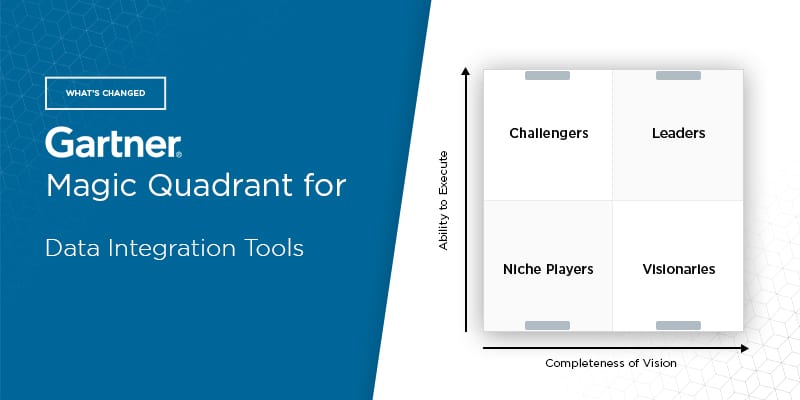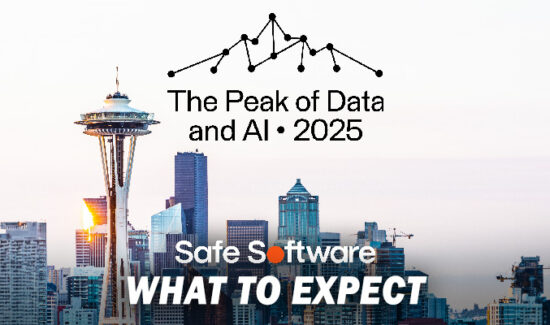What’s Changed: 2020 Gartner Magic Quadrant for Data Integration Tools


The editors at Solutions Review highlight what’s changed since the last iteration of Gartner’s Magic Quadrant for Data Integration Tools and provide analysis of the new report.
Analyst house Gartner, Inc. recently released the 2020 version of its Magic Quadrant for Data Integration Tools. Demand for data integration software is increasingly being driven by the requirements of hybrid and multicloud data management, as well as data fabric designs. The researcher also notes augmented data management as a major input in that it will reduce the reliance on IT for repetitive and low-impact tasks. The application of graph processing and databases also figures to be a factor in demand for data integration tools in the near term.
Gartner defines data integration tools as: “architectural techniques, practices and tools that ingest, transform, combine and provision data across the spectrum of data types.” The best data integration providers offer products that enable construction and implementation of data access and delivery for a number of key use cases. The most common ones include integration and delivery for optimizing analytics, sourcing master data, ensuring data quality and consistency between applications, data acquisition and sharing, data migration, and support for data management and governance.
As a strategic planning assumption, Gartner projects that over 80 percent of organizations will use more than one cloud service provider for their data and analytics by 2025. This makes it important for them to prioritize independent and cloud service provider-neutral data integration tools to avoid the dreaded vendor lock-in. It should also be a key consideration for buyers to hone in on which data integration delivery types they require and make product purchasing decisions accordingly.
Gartner adds: “Organizations that seek tools that are generalists (or best of breed in data integration) and can support multiple use cases though a combination of different data integration styles can evaluate the vendors mentioned in the Challengers and Leaders Quadrants. In addition, vendors in the Leaders quadrant are focused on new demands for automation in various aspects of data integration. These include design, ingestion, schema mapping, schema drift detection and corrections, next-best transforms, automated lineage and impact analysis, and infrastructure management and orchestration.”
In this Magic Quadrant, Gartner evaluates the strengths and weaknesses of 20 providers that it considers most significant in the marketplace, and provides readers with a graph (the Magic Quadrant) plotting the vendors based on their ability to execute and their completeness of vision. The graph is divided into four quadrants: niche players, challengers, visionaries, and leaders. At Solutions Review, we read the report, available here, and pulled out the key takeaways.
Gartner adjusts its evaluation and inclusion criteria for Magic Quadrants as software markets evolve. As a result, Fivetran, HVR, Matillion, Precisely (formerly included as Syncsort), and Safe Software have been added to the report.
It’s just another year atop the Magic Quadrant for Data Integration Tools for Redwood City-based Informatica. It retains a close (and tightening) edge over IBM due to its strong support for data fabric and augmented data integration support, as well as a focus on capabilities convergence and cloud service provider-agnostic integration. IBM touts strong support for its data integration tools and offers a diverse range of integration delivery styles and architectures. The enterprise technology mega-vendor has also aimed to make its data integration suite more consumable via repackaged capabilities.
SAP, Oracle and Talend form a cluster in the middle section of the Leaders column after Talend saw its standing upgraded slightly from last year. SAP offers a comprehensive data integration platform, what Gartner dubs as “seamless data orchestration capabilities” for a number of personas, and top-notch customer service. Oracle is well-positioned to support the emerging data fabrics use case and currently has a strong focus on data management feature convergence. Talend is focused on database-agnostic and multicloud hybrid data integration and touts a strong data management portfolio as well.
As we recently predicted would be the case, Denodo has been moved into the Leaders space, making its debut alongside SAS on the left side of the bracket. Gartner reference customers enjoy the Denodo catalog and its contextual information delivery. Support for automating data fabric design and high scores for customer service and user training have Denodo’s arrow pointing straight up. SAS lost a fair bit in its ranking for completeness of vision across Gartner’s horizontal axis, but the independent mega-vendor offers enhanced support for diverse user personas and improving augmentation and orchestration and remains a major player in data integration tools.
Microsoft and Qlik are retaining their respective positions in the Challengers column largely unchanged from 2019. Reference customers continue to report low total cost of ownership and ease of use as major reasons for adopting Microsoft. Qlik offers an easy-to-use data replication solution that it acquired from Attunity. Reference customers rave about simple installation, configuration and automated code generation as well. Qlik has now successfulyl integrated its Attunity acquisition with the rest of its data and analytics tool set.
TIBCO and Precisely (formerly Syncsort) have both been updated to data integration Challengers for 2020. TIBCO is strongest for real-time and edge data integration use cases, and its acquisitions over the last few years have helped to strengthen its broader set of integrated data management functionality. Precisely has a focus on data management infrastructure modernization. The vendor offers excellent post-sales technical support and perhaps the most broad set of data management features of any provider in this space.
Information Builders (ibi) and SnapLogic remain Visionaries in data integration tools for the second-straight year. ibi offers capabilities for an array of data integration styles and implementations. The vendor’s products are buoyed by augmented data quality and enablement of data engineering for analytics through embedded data preparation. SnapLogic continues to focus on cloud-based data integration approaches via its Intelligent Integration Platform. The provider also offers embedded and automated guidance to help simplify the development of integration flows.
Safe Software makes its debut toward the top of the Niche Players bracket with a strength in spatial data integration (with native support for Esri, GIS and OSIsoft). Gartner reference customers like Safe for its ease of install and setup, as well as ongoing support and high-quality end-user training and documentation. Safe Software also offers self-service data preparation. Hitachi Vantara made a notable move in completness of vision across Gartner’s horizontal axis for 2020. The company’s data integration solution provides visual tools that allow users to ingest, blend, cleanse and prepare data from a variety of data sources.
Though there’s nothing to report about Adeptia’s position on the graph, Gartner notes that its data integration product, Adeptia Connect, now offers improved usability through enhanced data preparation and augmented capabilities. Adeptia also touts strong customer feedback. Actian users speak highly of its lightweight data integration tool because it’s easy-to-use, reliable, and has the ability to handle complex workloads. Actian’s pricing strategy and deployment flexibility also make it a product to consider for niche use cases.
HVR, Matillion and Fivetran all make their first Magic Quadrant appearances clustered together in the lower-third of the Niche Players column. HVR has partnerships with AWS, Microsoft, Snowflake and Google Cloud Platform that allow it to replicate data across commonly used endpoints for cloud migrations. HVR reference customers also report above average for product or service queries. Matillion offers targeted data integration tooling for a variety of user personas and flexible pricing in support of cloud integration scalability. Like Matillion, Fivetran also offers cloud-centric integration technologies. Its platform was purpose-build for cloud-first integration, and it offers low total cost of ownership via consumption-based pricing on the number of rows processed.




















